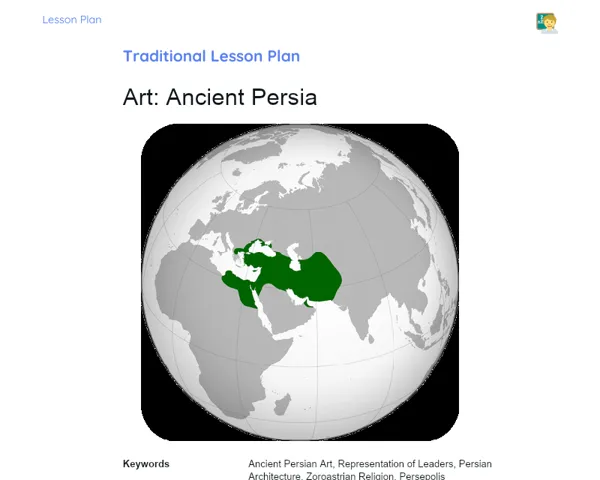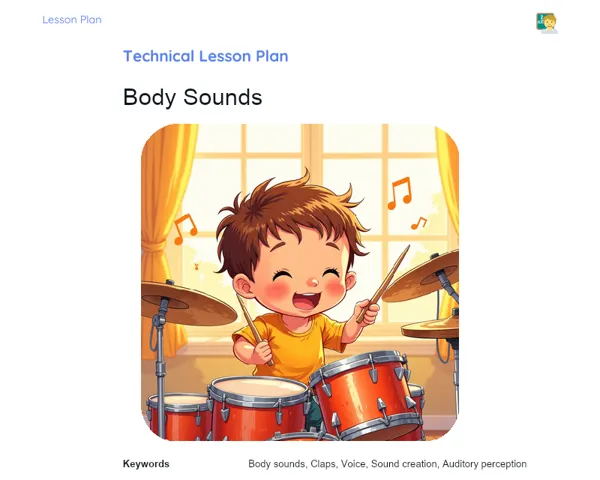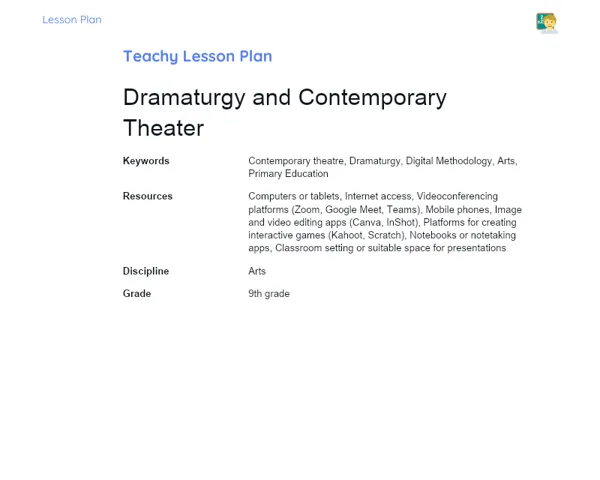Lesson Plan | Active Methodology | Musical Construction
| Keywords | Musical Construction, Music Components, Rhythm, Melody, Harmony, Timbre, Collaborative Practice, Musical Analysis, Musical Culture, Interactive Activities, Musical Composition, Percussion, Rhythm Notation, Theoretical Application, Musical Appreciation |
| Necessary Materials | A variety of percussion instruments, Rhythm notation cards, Audio playback device, Internet access for research, Paper and pens for taking notes, Tracks from various styles and cultures |
Premises: This Active Lesson Plan assumes: a 100-minute class duration, prior student study both with the Book and the beginning of Project development, and that only one activity (among the three suggested) will be chosen to be carried out during the class, as each activity is designed to take up a large part of the available time.
Objective
Duration: (5 - 10 minutes)
This section is essential for guiding both teachers and students on the lesson's focus. By clearly outlining the objectives, we ensure that everyone knows what is expected, streamlining the learning process and allowing students to leverage their prior knowledge effectively—maximising the benefits of hands-on activities in class.
Objective Utama:
1. Help students grasp the basic structure of music by identifying its key components: melody, harmony, rhythm, and timbre.
2. Enhance their ability to analyze rhythm, distinguishing various time signatures and beats.
Objective Tambahan:
- Encourage students' appreciation for music by linking music theory to practical auditory experiences.
Introduction
Duration: (20 - 25 minutes)
This introductory phase aims to engage students and build on their existing knowledge of musical components, especially rhythm. Through problem-based scenarios, students are encouraged to think critically, applying what they've learned in a practical and relatable manner. Contextualising Music’s relevance in everyday life will boost students' interest and motivation for the lesson.
Problem-Based Situation
1. After covering the elements of music, challenge students to identify and explain how rhythm manifests in different musical genres, such as jazz, rock, and classical. For instance, they could analyse the differences between simple and complex rhythms in two contrasting songs.
2. Use well-known tracks to help students connect the musical components to real-world examples. They might examine the melody, harmony, and rhythm of a contemporary hit like 'Shape of You' by Ed Sheeran.
Contextualization
Music is woven into the fabric of nearly every culture and holds significant importance in our lives, serving as artistic expression, entertainment, and even a therapeutic outlet. Exploring how various cultures interpret and use music can provide an interesting context for studying its components. For example, examining how rhythm and beat play a role in African festivals to bring people together and convey stories, or how the intricate polyphony in European classical music showcases complex compositional methods.
Development
Duration: (70 - 75 minutes)
This development phase allows students to actively apply the concepts of rhythm and musical structure they’ve learned previously. Group work fosters collaboration and communication skills. Each activity is designed to be engaging, hands-on, and contextual, ensuring that students can explore and deepen their understanding of music in an enjoyable and meaningful manner.
Activity Suggestions
It is recommended that only one of the suggested activities be carried out
Activity 1 - Global Rhythms Challenge
> Duration: (60 - 70 minutes)
- Objective: Analyse and understand how different communities utilize rhythm in music to convey identity and tradition.
- Description: Students will be organised into groups of up to 5, with each group assigned a specific continent. They will research and present a traditional music type from that continent, analysing how rhythm is constructed and used in expressing emotions or storytelling within that musical context.
- Instructions:
-
Divide the class into groups of up to 5 students.
-
Assign a continent to each group.
-
Ask each group to research and select a traditional song from that continent, with a focus on the rhythm.
-
Students will study the rhythm of their chosen song, identifying patterns and instruments.
-
Each group will prepare a 10-minute presentation explaining the rhythmic structure of their song and its cultural significance.
Activity 2 - Composition Builders
> Duration: (60 - 70 minutes)
- Objective: Apply concepts of rhythm and time signatures in a creative way, fostering collaboration and artistic expression.
- Description: In their groups, students will create a simple musical composition using the percussion instruments available in the classroom. The aim is to apply their understanding of rhythm and time signatures to create an engaging piece that showcases both harmony and rhythm.
- Instructions:
-
Split the class into groups of up to 5 students.
-
Provide each group with a selection of percussion instruments.
-
Introduce basic concepts of rhythm and time signatures, explaining their role in musical composition.
-
Students will have 30 minutes to experiment and develop their composition, focusing on a main rhythm and its variations.
-
Each group will present their composition to the class, explaining their choices and the emotions they aimed to convey through the music.
Activity 3 - Rhythm Detectives
> Duration: (60 - 70 minutes)
- Objective: Develop listening skills and the ability to associate musical rhythms with their notations, solidifying their understanding of rhythm’s structure.
- Description: In this fun guessing game, groups will be given cards containing excerpts of sheet music representing rhythms from various songs. They’ll listen to snippets of the respective songs and try to match the rhythm card with the melody or beat they hear.
- Instructions:
-
Form groups of up to 5 students.
-
Distribute a set of rhythm notation cards to each group.
-
Play excerpts from different songs and get the groups to match the heard music with the correct rhythm card.
-
Groups will score points for each correct match.
-
The group with the highest points at the end of the game is the winner.
Feedback
Duration: (10 - 15 minutes)
This feedback session is vital for consolidating the learning from the practical activities. Through discussion, students can verbalise and reflect on their takeaways, supporting knowledge retention. Additionally, hearing from their peers can provide fresh perspectives and enhance their overall understanding of the subject matter.
Group Discussion
At the end of the activities, host a large group discussion to allow students to share their group's findings and experiences. Begin with an overview of the importance of understanding rhythm’s structure in music. Encourage each group to summarise their discoveries and highlight any challenges or breakthrough moments they experienced. Use this time to connect individual experiences with broader musical and cultural concepts.
Key Questions
1. What were the main challenges faced when trying to apply theoretical knowledge of rhythm during the activities?
2. In what ways can understanding rhythm's structure enhance our comprehension of different musical genres?
3. Were there any surprises or unexpected insights gained during the activities?
Conclusion
Duration: (5 - 10 minutes)
The conclusion serves to consolidate and reinforce the learning that took place during the lesson, ensuring students have a clear grasp of the topics covered. By emphasising the practical application of theoretical ideas and their relevance to everyday life, this section encourages students to appreciate the value of their learning and motivates them to continue exploring the world of music.
Summary
To wrap up, summarise the key points discussed throughout the lesson, reinforcing the students' understanding of music components, especially rhythm. Recap the activities, such as the 'Global Rhythms Challenge,' 'Composition Builders,' and 'Rhythm Detectives,' highlighting key discoveries and insights gained by each group.
Theory Connection
Today's lesson effectively bridged theory and practice, allowing students to apply theoretical concepts around rhythm and musical structure through hands-on activities. The exercises were designed to showcase how different cultures use rhythm across various musical styles, underscoring the importance of music theory in appreciating and creating music meaningfully.
Closing
It's vital to stress the relevance of studying music and its components in our daily lives. Understanding music construction and how rhythm shapes our emotions and perceptions can enhance students' musical experiences and empower them artistically, whether as informed listeners or budding music creators.



